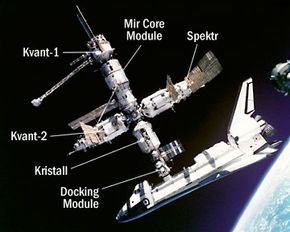Mir: the First Permanent Space Station
In 1986, the Russians launched the Mir space station, which was intended to be a permanent home in space. The first crew, cosmonauts Leonid Kizim and Vladymir Solovyov, shuttled between the retiring Salyut 7 and Mir. They spent 75 days aboard Mir. Mir was continually manned and constructed over the next 10 years and contained the following parts:
- Living quarters - housed individual crew cabins, toilet, shower, kitchen and trash storage
- Transfer compartment - where additional station modules could be attached
- Intermediate compartment - connected working module to the rear docking ports
- Assembly compartment - housed the fuel tanks and rocket engines
- Kvant-1 astrophysics module - contained telescopes to study galaxies, quasars and neutron stars
- Kvant-2 scientific and airlock module - provided equipment for biological research, Earth observations and spacewalk capabilities
- Kristall technological module - used for biological and material processing experiments; contained a docking port that could be used by the U.S. space shuttle
- Spektr module - used for investigations and monitoring of the Earth's natural resources and Earth's atmosphere, and to support biological and materials science experiments
- Priroda remote sensing module - contained radar and spectrometers to study the Earth's atmosphere
- Docking module - contained ports for future shuttle dockings
- Progress supply ship - unmanned resupply ship that brought new food and equipment from Earth and removed waste materials from the station
- Soyuz spacecraft - provided main transport to and from Earth's surface
In 1994, as preparation for the International Space Station (ISS), NASA astronauts (including Norm Thagard, Shannon Lucid, Jerry Linenger and Michael Foale) spent time aboard Mir. During Linenger's stay, Mir was damaged by an onboard fire. During Foale's stay, a Progress supply ship crashed into Mir.
Advertisement
The Russian space agency could no longer afford to maintain Mir, so NASA and the Russian space agency had planned to junk the station in order to concentrate on the ISS. A private movement (Keep Mir Alive!) and a company (MirCorp) publicly campaigned to repair and privatize the aging space station. However, the Russian Space Agency decided on November 16, 2000, to bring Mir down to Earth. In February 2001, Mir's rocket engines were fired to slow it down. Mir re-entered the Earth's atmosphere on March 23, 2001, burned and broke up. Debris crashed in the South Pacific Ocean about 1,000 miles (1,667 km) east of Australia. This marked the end of the first permanent space station.
Now, we'll take a glance at the International Space Station.
